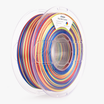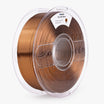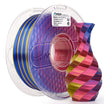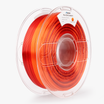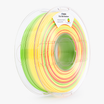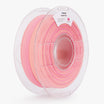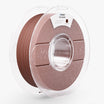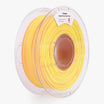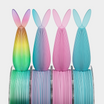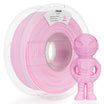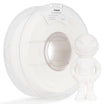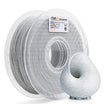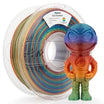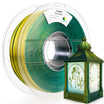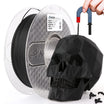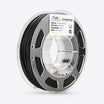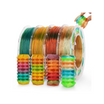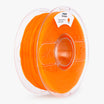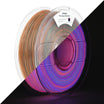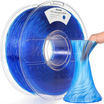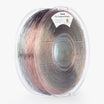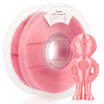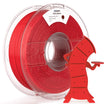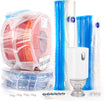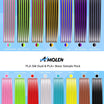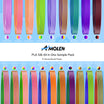Most people choose PLA because it's considered the safest printing filament, but the term "safe" deserves a closer look. While the base plastic is non-toxic, the process of melting it releases fumes, and the filament itself contains various chemical additives. This isn't a cause for alarm, but it is a reason for awareness. Here, we'll cover the practical safety aspects of using PLA and the straightforward steps you can take to minimize any risks.
PLA: A Fundamentally Safe Material
Polylactic Acid (PLA) isn't like conventional plastics. It is a non-toxic bioplastic, most commonly produced from renewable sources such as corn starch or sugarcane.
Its safety profile is so well established that it is used widely in the medical industry for sensitive applications, such as dissolvable surgical sutures and internal implants that degrade harmlessly inside the human body.
Hence, in its raw, solid form on the spool, PLA plastic is inert and is not a cause for any concern. The safety issues that need to be addressed do not arise from the material itself, but from the use of it.
What Are the Actual Risks of Printing PLA?
While PLA material itself is safe, the process of heating, printing, and finishing it introduces three main risks that you should be aware of.
Risk 1: Fumes and Particles from the Printing Process
Melting plastic in an FDM printer releases two types of emissions into the air:
- Ultrafine Particles (UFPs): Microscopic plastic particles that can be inhaled. All printers release these, regardless of the filament used.
- Volatile Organic Compounds (VOCs): Chemical gases released by heat. The type and amount depend on the plastic.
When it comes to these emissions, PLA is a much safer option than other filaments.
- PLA: Releases very low levels of VOCs. Its primary emission is lactide, which is not considered very hazardous. The faint, sweet smell from printing PLA is not a sign of danger.
- ABS: Releases high levels of VOCs, including styrene, a known hazardous air pollutant. The strong chemical smell is a clear warning sign, which is why ABS requires an enclosure and excellent ventilation.
Even with PLA's low emissions, it's still best to avoid breathing any printing fumes for long periods.
Risk 2: Unknown Additives in Filaments
The filament you use is rarely 100% pure PLA. Manufacturers add various chemicals to create specific colors, finishes (like silk or matte), or to improve physical properties (like in PLA+).
These additives are the biggest unknown variable. While reputable brands tend to use safe, non-toxic pigments, there are no regulations that require companies to disclose their formulas. Cheaper filaments from unknown sources could contain hazardous materials, such as heavy metals in some colorants. This is a good reason to buy from well-known manufacturers who can provide a Safety Data Sheet (SDS).
Risk 3: Plastic Dust from Sanding
Sanding a finished print to smooth its surface creates another risk: fine plastic dust. Inhaling this dust can irritate your respiratory system. To prevent this, you should always sand in a well-ventilated area and wear a quality dust mask (N95 is a good standard). An even better method is wet-sanding, which involves wetting the sandpaper to prevent the fine plastic dust from going airborne in the first place.
Is PLA Food-Safe?
The short answer is no, not without a food-safe coating. Even if a filament is made from food-safe base materials, the process of 3D printing makes the final object unsafe for direct or repeated contact with food.
There are three main reasons for this:
- Layer Lines Breed Bacteria: The tiny, unavoidable gaps between the layers of a 3D print are a perfect breeding ground for bacteria. These crevices cannot be cleaned or sanitized effectively, allowing germs to build up quickly after use.
- Contamination from the Printer: Most standard printer nozzles are made of brass, which can contain small amounts of lead that may transfer to the print. Your printer's hotend can also hold residue from other, non-food-safe filaments you've used in the past.
- Unknown Additives: As we covered earlier, the various colorants and performance-enhancing additives in the filament are not certified for food contact and could potentially leach into your food.
Due to these concerns, it is not advisable to use a raw PLA print for a cereal bowl or a coffee cup. The danger is less for objects with minimal, short-term contact that don't need vigorous washing, like a cake topper or a cookie cutter.
The sole method for making a 3D print food-safe is to coat its complete surface with a certified food-grade epoxy or coating. This provides a smooth, non-porous, and washable barrier between the food and plastic.
Practical Steps for Safe PLA Filament Printing
It is correct to treat your 3D printer as you would any other workshop tool. Observing some basic safety guidelines will eliminate almost all of the possible risks of emissions, regardless of which material you are printing.
Ventilate Your Workspace
This is the most important rule. At a minimum, open a nearby window. For better results, use a fan to create a clear air path, pushing fumes away from you and towards the open window. The goal is to prevent particles and gases from building up in the air you breathe. Never operate a printer for long periods in a small, sealed room.
Use an Air Purifier
An air purifier sitting next to the printer works extremely well. Find a machine with two kinds of filters: a HEPA filter, which works like a fine mesh to trap the physical ultrafine particles (UFPs), and an activated carbon filter, which traps the gas-based volatile organic compounds (VOCs).
Consider an Enclosure
A basic enclosure around your printer captures a significant amount of emissions. This also enhances print quality by maintaining a consistent temperature. For optimum performance, you can adapt an enclosure with a small fan and a duct hose that exhausts the air directly outside a window.
Wear a Proper Mask for Post-Processing
For sanding, drilling, or cutting prints, a plain cloth mask won't do to prevent inhalation of fine plastic dust. Wear a mask with a rating of N95 or greater since it is specifically engineered to catch these minute airborne particles and keep them from entering your lungs.
Keep Your Distance
This is just basic physics: the density of particles in the air decreases substantially as you get further from the source. Don't sit directly beside a printing printer for hours. Shifting your workstation a few more feet away can dramatically decrease your total exposure over the course of a lengthy print.

Print with Confidence and Care!
PLA is still the safest and easiest-to-use filament on the market, and it is a great option for both professionals and hobbyists. Its low-level dangers are controllable risks and are a result of the general process of melting plastic, not the material itself. With proper ventilation and some common-sense safety precautions, you can continue to safely and confidently make great things with your 3D printer.

